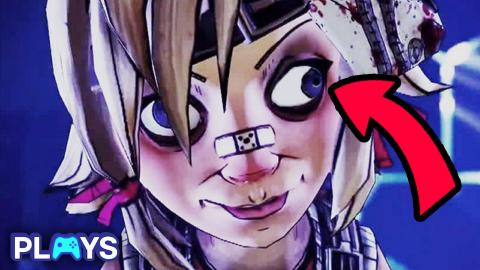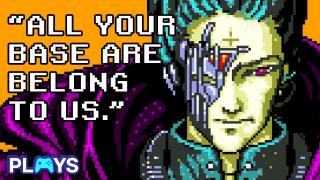10 MISTAKES Video Game Developers Intentionally LEFT IN

The Frying Pan
10 Big Mistakes Devs Left in Games
“PUBG: Battlegrounds” (2017) One might think a frying pan to be the most useless weapon in a battle royale where all types of guns can be acquired. Well, one would be wrong. The frying pan from “PUBG” has grown exceptionally popular thanks to it being bulletproof. However, this feature was a mistake. According to creator Brendan Greene, the studio had been experimenting with the ability to deflect a grenade with the pan. But this feature went live before it was ready, and Greene soon found that the pan could deflect bullets as well as grenades. Players then found all kinds of incredible and hilarious ways to use it, such as a well-timed swat to parry a sniper rifle round. Silly, yes, but honestly incredible.
Preserving History
“The Legend of Zelda: Ocarina of Time 3D” (2011) “Ocarina of Time” may be one of the best games ever made, but it’s not without its fair share of bugs. There are many that let you reach areas you aren’t supposed to or play in different ways, which we’re sure have been a lot of fun to exploit by the speedrunning community. When the game was remade for the 3DS, developer Grezzo chose not to remove any bugs unless they actively harmed the experience. Several staff members had grown up with the game and had fond memories of messing around with the various glitches. Grezzo wanted to enhance the presentation, but keep the nostalgic love for the original. And for many players, the bugs are a part of that.
Chamber 14
“Portal” (2007) “Portal” is popular for a lot of justifiable reasons, though chief among them are the pristinely-crafted puzzles. Each one is designed with a specific solution in mind, leading to incredibly satisfying moments when you crack them. However, one featured an alternative solution that many thought to be unintentional. Well, it was. In Test Chamber 14, it’s possible to bypass everything, flinging yourself to the exit in a matter of seconds. The game’s commentary explains Valve discovered this method, but left it in. It requires perfect timing and accuracy, so the developer felt it should be left in for skilled players to attempt it. In fact, to get Gold in each of the Chamber’s challenges, you actually have to use this method.
Combo Bug
“Street Fighter II” (1991) These days, it’s hard to imagine a fighting game not including combos. But the advent came about entirely by accident. Some time during “Street Fighter II’s” development, producer Noritaka Funamizu was doing a bug check for a bonus stage in which players beat up a car. He noticed that, when timing it properly, one could add a second hit directly after the first one. Unaware of how useful it would become, Capcom left this in as a hidden feature. Of course, being able to string different moves together while your opponent is helpless to stop you is partially what made the game so unique. Capcom would revisit and refine it for future iterations, and thus the combo system was born.
An Eye For Trouble
Top 5 Most Respected Video Game Developers
“Borderlands 2” (2012) The “Borderlands” series is overflowing with eccentric characters, with wacky designs to match them. However, none are quite as memorable as Tiny Tina. Introduced in “Borderlands 2” and voiced by the talented Ashly Burch, the violent and chaotic tween stole every scene she was in. Many players noticed that her left eye had a tendency to be a bit lazy and assumed this was a conscious decision made by Gearbox. However, that wasn’t the case. Tina’s lazy eye was simply a bug, but the developers thought it fit her so well, they decided to keep it in. This physical descriptor was also carried over to future appearances, as the eye will often twitch while she talks.
Teleporting Watson
“Sherlock Holmes: Nemesis” (2008) Sherlock Holmes is a perfect character for the point-and-click adventure genre, a fact which developer Frogwares has capitalized on for multiple games. However, 2008’s “Nemesis” gained recognition for an entirely different reason. During gameplay sections, in which you control Holmes from a first-person perspective, Watson doesn’t have a walking animation. Instead, he’ll teleport by your side as soon as you look away. This gave birth to the ‘Creepy Watson’ meme, with many thinking it an unintentional bug. This was actually intended by the developer; not having to animate Watson walking likely saved on time, and it’s not as if it was necessary. Still, when the game was remastered in 2010, Creepy Watson was put to rest.
Companion Behavior
Top 10 Heartbreaking Companion Deaths in Video Games
“Fallout 3” (2008) The wasteland can be a dangerous place, which is why it’s always nice to have a companion traveling with you. And while you might expect a video game companion to follow your every demand, those here do not. The companions were added late in development. Instead of writing entirely new code, Bethesda simply copied and tweaked that of NPCs. Therefore, some will want a trade or money in exchange for items you may need. This was kept in to make the companions a bit more dynamic. Another feature of companions carried over from NPCs is immunity to radiation. This feature also wasn’t intended, but was kept by the developers as they thought it would annoy players to heal companions on top of themselves.
Dumpster Grenade
“Half-life 2: Episode Two” (2007) Things get pretty intense in “Half-life 2” and its expansions, so it was nice of Valve to include something a little bit fun. However, it wasn’t on purpose. At a certain point in the story, you can find a dumpster with an enemy inside. You can hear it digging around and see boxes inside the dumpster moving. The movement and sound was achieved with a bit of programming called a physics explosion. However, one tester decided to throw a grenade into the dumpster, and was surprised to find it chucked back out. This was merely a bug caused by how the sequence was programmed, but Valve thought the idea of an enemy throwing your grenade back to you was too funny not to keep.
An Inescapable Trap
Top 10 Times Game Developers Got Confrontational
“Sonic the Hedgehog 3” (1994) After suffering a few humiliating defeats, it’s only natural that Eggman would want to increase the lethality of his traps. But this is just ridiculous. In “Sonic the Hedgehog 3,” it’s possible to reach such immense speeds that Sonic will clip into an object or bit of environment and get stuck inside. These types of bugs are far from uncommon. What is uncommon is for them to be left in intentionally. It seems Sega was not only well-aware of the bug, but actually made it part of Eggman’s ingenuity. The game’s manual makes mention of it, advising you to avoid traps Sonic can’t escape and stating you may have to reset your system should you fall into them.
Faster Enemies
“Space Invaders” (1978) There are many classic arcade games that influenced the future of the medium, and Taito’s “Space Invaders” is one of the most important. Players controlled a single defender taking on waves of aliens that continuously inched closer. The more enemies you defeated, the faster the remaining ones moved. It was the dawn of a scaling difficulty curve, yet it was entirely by mistake. Designer Tomohiro Nishikado made it so the enemies’ positions were updated after each frame of animation. But he also found that the hardware could render animation faster with less of them on screen, leading to an accidental increase in speed as more of them died. Instead of fixing it, he kept it as part of the gameplay, a decision that undoubtedly helped it in the long run.





